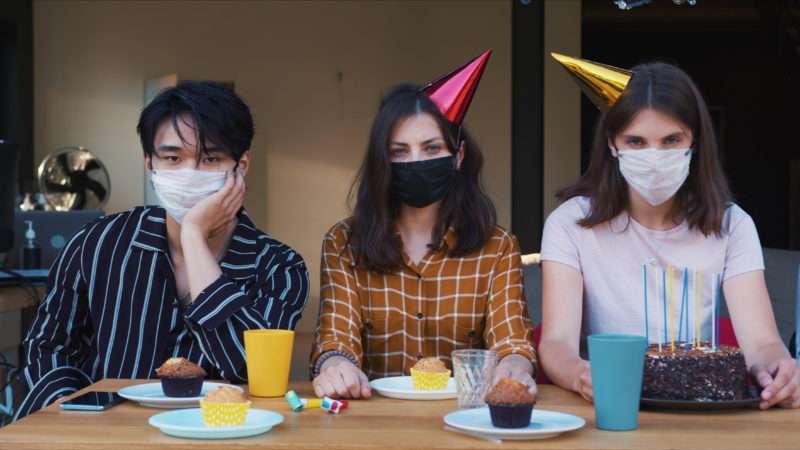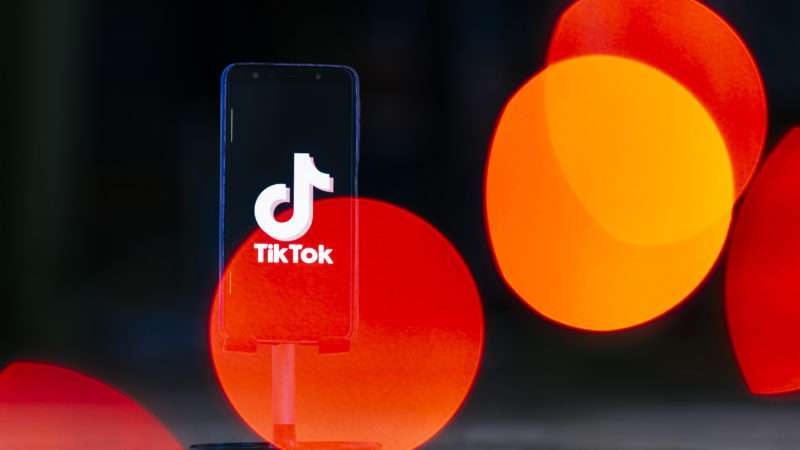It was a gorgeous August weekend in New York City, and Andy—a college senior at New York University (NYU)—decided to attend a rooftop social gathering with his roommates.
The party was consistent with New York City’s Phase 4 COVID-19 guidelines, which allow events of up to 50 people. Many attendees went mask-less, but Andy says he didn’t stand in close proximity to anyone other than his roommates—who are also students—and they left after a short while.
But unbeknownst to Andy—whose name has been changed for this article to protect his privacy—someone at the party posted a video of the event on social media. Andy never saw this video, but he knows that he was visible in it. The video was reported to NYU administrators via the university’s COVID-19 compliance system. On Sunday, August 23—a day after the party—NYU Director of Student Conduct Craig Jolley sent an email to Andy accusing him of “threatening the health and safety of the NYU Community.” By 5:00 p.m. on Monday, NYU had suspended him indefinitely: To return to campus in 2021, Andy will need to write a reflection paper and beg for readmission. Resuming his education might be impossible, anyway, since he relies on a full-tuition scholarship that is now threatened by his disciplinary status.
Andy thinks NYU treated him unfairly. It’s hard to disagree. Importantly, he didn’t actually put anyone on campus in danger, because he had no plans to set foot on NYU property: He lives off campus, and all his classes were online.
“I am not a student who will be staying at or near NYU housing, nor will I be entering Campus Grounds or NYU buildings as I am currently enrolled in all online courses,” Andy wrote in his appeal of the decision.
The appeal was rejected.
***
The COVID-19 pandemic is a multifaceted disaster, casually crippling vast swaths of the U.S. economy, bringing social interaction to an unexpected and unprecedented halt, and of course, killing more than 200,000 Americans. The challenges are daunting for many people, organizations, and industries—U.S. higher education certainly among them.
Colleges and universities have adopted a wide variety of strategies. Some have decided that in-person instruction is simply impossible: In May, California State University (CSU) became the first to announce that the fall semester would be online-only. Earlier this month, CSU made the same call regarding the 2021 spring semester.
Many other universities, perhaps realizing that students will balk at paying full tuition for a series of glorified online tutorials, attempted to reopen in various stages and forms. But these reopenings were accompanied by tough restrictions on student social gatherings in dormitories, off-campus housing, and elsewhere. Evidently, administrators expected that students would be willing to come to class, learn, then hurry back to their residences—and stay there. At many campuses, near-perfect compliance with extreme social distancing requirements on the part of students was not merely a requirement, schools assumed they would comply.
“Everything we have done—the months of planning to give our students the opportunity to continue their educational pursuits in person—can be undone in the blink of an eye with just one party or event that does not follow the rules and guidelines,” said Katie Sermersheim, Purdue University’s dean of students, in a statement detailing the school’s no-parties pledge.
Carl Bergstrom, a professor of biology at the University of Washington, likened Sermersheim’s admission that non-universal compliance will destroy the strategy to “an evacuation plan that will work perfectly as long as the building isn’t on fire.”
“Why would anyone admit that their months of planning would collapse if students hold a single party?” he wondered on Twitter.
Universities that believe they can ban many or all social functions for students are essentially conducting an experiment that has been run many times, from the era of Prohibition to modern abstinence-only education. The results of this latest experiment are in, and they are familiar: Students will party, COVID-19 be damned.
The University of North Carolina at Chapel Hill, for instance, opened for in-person learning on August 10. By August 17, the school had decided to go online-only for the duration of the semester following a dramatic spike in coronavirus cases on campus. In an editorial, The Daily Tarheel, which reported numerous parties during the first weekend back at school, chided university leadership for failing to anticipate that students, “many of whom are now living on their own for the first time,” would be reckless. “Reports of parties throughout the weekend come as no surprise,” wrote the student editors.
The social gatherings are entirely unsurprising. But that’s not because students are uniquely incautious. On the contrary, students are just like the rest of us—trying to manage risk while still living life, months beyond the point where most people expected they would be able to go back to normal. (Remember “15 days to slow the spread”?) These risks are not the same for all people—age and health status matter—and they are not equally significant in all circumstances—outdoor events are not indoor events. And people who take on some amount of risk do not always attract equal levels of moral condemnation. Assuming that virtually everyone would obey orders, not just to be more careful than usual, but to live a sad and isolated existence indefinitely—perhaps that was reckless.
Events resembling what happened at UNC have transpired on dozens of campuses, and hundreds of students have already suffered suspensions. Purdue kicked 36 kids off campus for partying without masks. St. Olaf College in Minnesota suspended 17. Syracuse University suspended 23. Northeastern University learned that a first-year student had conducted a poll asking classmates whether they intended to party, despite the school’s restrictions. When more than 100 students responded in the affirmative, the pollster forwarded their names to administrators, who then threatened the students—and their parents—via email.
“You have displayed a disregard for health and safety measures, jeopardized our chances to keep our community safe, and increased the possibility that you and others—including your classmates—might not be able complete the semester,” wrote the school, before demanding that they sign a pledge to improve their behavior.
Northeastern eventually suspended 11 students for partying. They will be allowed to return in the spring. Their tuition for the aborted fall semester—a whopping $36,500—will not be refunded.
***
Andy’s financial hit is indirect but no less serious. His suspension is likely to result in the loss of his full-tuition scholarship, which means he would not be able to afford NYU, even if the administration lets him return. He also has a job offer with a bank that is contingent upon his successful graduation, he told Reason.
“I considered looking at legal action, though I might be out of my budget,” he says. “I contacted a lawyer. She was just ball-parking some numbers and they seemed unreasonable.”
Following their receipt of the social media video—emailed to covidcompliance@nyu.edu, the university’s hotline for reporting noncooperation—NYU administrators accused Andy of violating three separate aspects of the student code of conduct: Policy B1, which prohibits “threatening” behavior that compromises health and safety; Policy E1, which prohibits “disorderly, disruptive, or antagonizing behavior that interferes with the safety, security, health or welfare of the community”; and Policy E3, which obligates students to follow the new COVID-19 guidelines when on campus.
“As you are likely aware, the University is responding swiftly and seriously to behaviors that threaten the health and safety of the NYU Community,” wrote Jolley, the student conduct office director, in his initial email to Andy. Jolley did not respond to a request for comment on this article.
Andy was invited to plead his case on a Zoom call but was given just 24 hours to prepare for it. Jolley rendered his verdict swiftly: Immediately after the call, Andy says he was informed that he was suspended.
Andy was devastated.
“A suspension for me is more than just a semester,” he says. “This adversely impacts my entire life.”
The university was unmoved.
“Considering the importance of creating a safe environment during a global pandemic, the University will not tolerate conduct which intentionally and recklessly disregards the rules and threatens the health and safety of others,” wrote Jolley. “Your behavior in this situation is unacceptable.”
Was it? Reasonable people can debate—and are debating, all over the country—what level of risk is acceptable, for themselves and others. Many people believe the decision to open campuses at all is reckless: Students and faculty affiliated with the University of Georgia’s educators’ union, for instance, held a die-in protest on the school’s law to oppose re-opening. Many educators with union protection expect to be paid, regardless of whether schools re-open, which gives them greater reason to lobby for additional delays. University administrators, on the other hand, probably realize that distance learning hurts their bottom line since it encourages customers—students and their parents—to explore other options. College reopening strategies around the country are based on profoundly misguided assumptions about human behavior.
Andy says he didn’t put the health and safety of other students at risk—he lives off campus and takes all his classes online. He also thinks the COVID-19 rules, as written, only apply to people who are actually present on campus, or in NYU buildings.
Adam Steinbaugh, an attorney with the Foundation for Individual Rights in Education, says Andy has a point.
“COVID-19 is not a computer virus, so unless this event involved a number of NYU students, any interest the university has in wielding its disciplinary procedures to deter the spread of COVID-19 among NYU students is pretty attenuated,” Steinbaugh tells Reason. “It’s hard to blame students for being surprised that this type of policy is being applied to their off-campus conduct.”
Steinbaugh reviewed Andy’s case at Reason‘s request (and with Andy’s permission). He thinks NYU is overreacting, and unless the rooftop party was itself in violation of New York City’s public health orders, it would be tough to justify the suspension.
“Universities appear eager to shift blame for ballooning COVID-19 infections to students,” says Steinbaugh, who notes that the reflection paper assigned to Andy in hopes of gaining readmission is supposed to “focus on the role young people have played in the transmission of COVID-19 in the United States.”
***
For now, Andy is trying to enroll in a different online college so that the semester is not a total waste.
“I’ve got to get some credit somehow,” he says.
He regrets going to the party and says that it wasn’t characteristic of how he has conducted himself during the pandemic.
“While it may not appear this way, I have been attempting to stay safe as best I can,” he wrote in his appeal. “My attempt to seek some feeling of normalcy was nothing more than a snap decision and I cannot emphasize how much I have learned from this process.”
Indeed, going back to school during a pandemic is proving to be an educational experience for everyone, including and especially the educators. School administrators are learning that they can’t quite overcome students’ natural inclinations—all they can do is process their tuition payments. The faster, the better, probably.
from Latest – Reason.com https://ift.tt/2RBdq6S
via IFTTT



